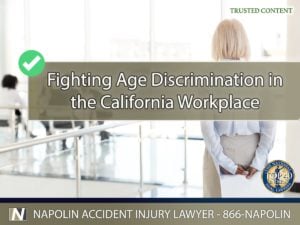Age discrimination in the workplace is a significant issue that affects a substantial segment of the workforce in California, particularly those who are 40 years old and above. This form of discrimination can manifest in various ways, from hiring practices to promotions and beyond. Understanding your rights and the legal avenues available is crucial for protecting yourself against unfair treatment based on age. In this article, we will explore the legal frameworks, both federal and state, that safeguard against age discrimination, provide practical advice on recognizing and documenting incidents, and discuss how to seek redress.

Understanding Age Discrimination in the Workplace
Understanding Age Discrimination in the Workplace
Age discrimination occurs when an employee or job applicant receives less favorable treatment specifically because of their age. This practice is prohibited under several laws but can still be subtly embedded in workplace cultures. In California, specific statutes protect workers aged 40 and older from discrimination in hiring, job assignments, promotions, terminations, and other aspects of employment. Recognizing the subtle signs of age discrimination, such as jokes about age or assumptions about technological proficiency, is the first step towards combatting it.
Legal Protections Against Age Discrimination
The legal framework protecting against age discrimination includes the federal Age Discrimination in Employment Act (ADEA) and California's Fair Employment and Housing Act (FEHA). The ADEA prohibits discrimination against persons 40 years of age or older, while FEHA offers broader protections, including harassment and retaliation related to age bias claims. These laws ensure that older employees can work without fear of unfair treatment due to their age. Understanding these laws is essential for anyone who feels they have been discriminated against based on their age.

Recognizing Signs of Age Discrimination
Recognizing Signs of Age Discrimination
Age discrimination might not always be overt and can occur in subtle interactions and company policies. Indicators can include exclusion from crucial meetings, inappropriate jokes about age, or a noticeable pattern of promoting only younger employees. Comments that might seem benign, like observations about ‘slowing down' or being ‘out of touch,' can be rooted in ageism. Documenting such comments and actions when they occur is vital in building a case should legal action become necessary.
Steps to Take if You Face Age Discrimination
If you encounter age discrimination, it’s important to document every incident in detail, noting dates, times, witnesses, and the context of each event. Consultation with human resources and review of company policies might also provide clarity and support. If internal resolution is not possible, filing a formal complaint with the California Department of Fair Employment and Housing (now the Civil Rights Department) is the next step. The CRD can mediate disputes and, if necessary, conduct a formal investigation.
Legal Recourses and Remedies
When age discrimination leads to a lawsuit, various remedies are available to the victim. These may include compensatory damages, back pay, reinstatement of employment, or changes in workplace policies to prevent future discrimination. Pursuing legal action with the help of knowledgeable counsel can ensure that all evidence is properly presented and that the victim’s rights are fully protected under both state and federal laws.
No one should have to face discrimination in the workplace because of their age. If you suspect that you are being treated unfairly due to your age, it is crucial to take immediate action. Napolin Accident Injury Lawyer is committed to protecting the rights of workers in California. Contact us at (866)-NAPOLIN for a free consultation to discuss your case. With our extensive experience in employment law, we are here to help you ensure justice and fair treatment in your workplace.
- Understanding Uber Accidents and Insurance Coverage Periods in California - April 8, 2025
- A Guide on Red Light Auto Accidents in California - August 14, 2024
- Self-Representing in a California Personal Injury Claim - August 13, 2024

